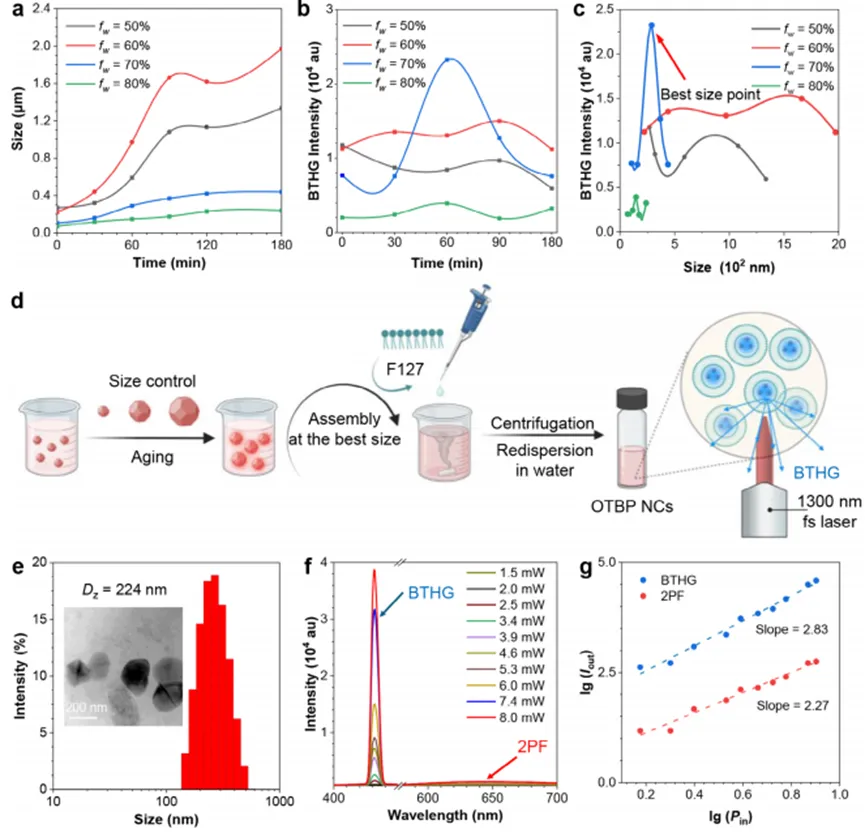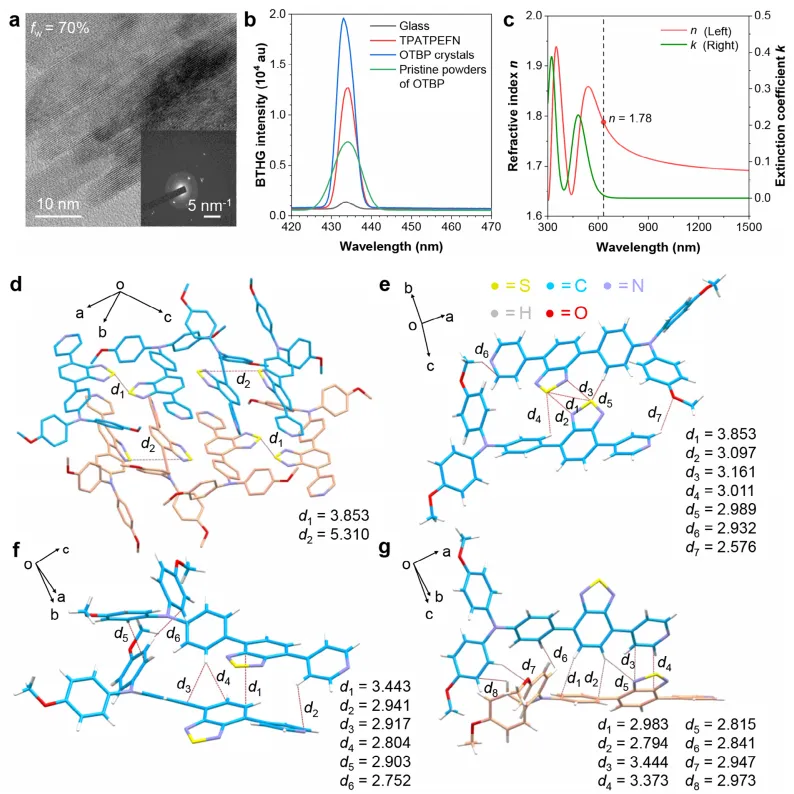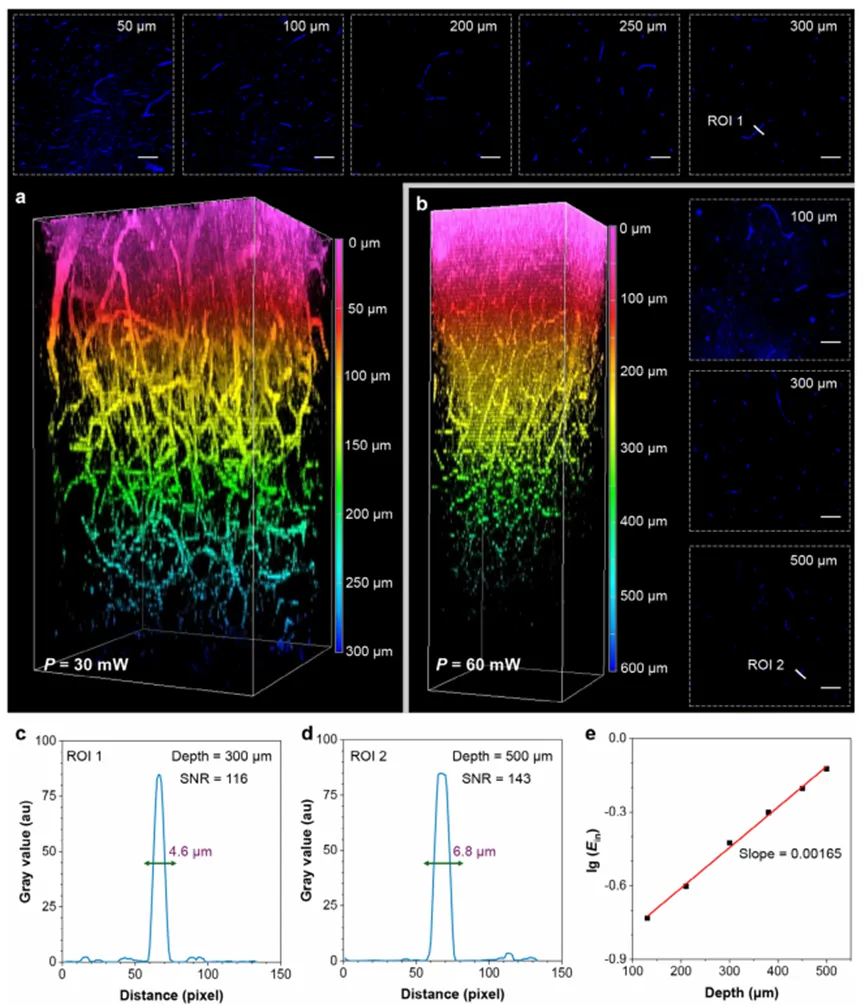A groundbreaking collaboration between Hong Kong and Macau research teams has led to significant advancements in nonlinear optics through organic aggregate regulation. By developing stable AIE nanocrystals with high refractive index, researchers have enhanced backward third-harmonic generation (BTHG) signal collection efficiency, enabling high-contrast imaging of deep-layer blood vessels in mouse brains under low-power laser excitation while minimizing photodamage risks.
Recently, a breakthrough has been achieved by the teams of Academician Ben Zhong Tang and Professor Rongye Lin from Hong Kong University of Science and Technology in collaboration with Professor Ziming Liu and Professor Changhuo Xu from the University of Macau. Through molecular design and mesoscopic regulation, they successfully developed stable AIE nanocrystals (OTBP NCs) with high refractive index (n = 1.78), significantly enhancing the collection efficiency of backward third-harmonic generation (BTHG) signals. Under low-power laser excitation of 60 mW (pulse energy of 0.75 nJ), OTBP NCs achieved high-contrast imaging of deep-layer (500 μm) blood vessels in mouse brains, while effectively suppressing autofluorescence background and the risk of photodamage.
Background: Nonlinear Optics and Aggregate Science
The field of nonlinear optics began its modern journey in 1960 when Theodore H. Maiman invented the first ruby laser, opening a new era in laser technology. Scientists subsequently discovered that when lasers interact with quartz crystals, they produce a series of nonlinear optical phenomena. Among these, third-harmonic generation (THG) has attracted particular attention due to its signal enhancement characteristics at interfaces.

THG is a four-wave mixing process where, for example, incident light at 1300 nm can be converted to THG at 433 nm. This technology offers high tissue penetration depth and detection sensitivity, making it widely applicable for label-free imaging of biological tissues. However, traditional THG materials face significant limitations, including low efficiency, difficulty in collecting backward signals, and poor biocompatibility.
In 2001, Academician Ben Zhong Tang proposed the revolutionary concept of “Aggregation-Induced Emission (AIE),” which revealed the unique optical behavior of aggregate materials. From molecular-level π-electron stacking and electron transfer to the correlation between aggregate morphology and function, scientists have gradually recognized the tremendous potential of aggregates in nonlinear optics.
The related work was published in Advanced Materials under the title “From Molecule to Aggregate: Designing AIE Nanocrystals for Low-Power Backward Third-Harmonic Generation Angiography,” representing a significant advancement in the field of biomedical imaging and nonlinear optics.

First authors: Lidong Du, Hanchen Shen
Corresponding authors: Academician Ben Zhong Tang, Professor Ziming Liu, Professor Rongye Lin, Professor Changhuo Xu
Institutions: Faculty of Health Sciences, University of Macau; Department of Chemistry, Hong Kong University of Science and Technology
Original publication: Advanced Materials (April 2025)
Research Findings
The research team designed two AIE molecules with donor-acceptor (D-A) structures: OTBP and ODBP. OTBP, featuring a larger π-conjugated system and transition dipole moment, demonstrated significantly stronger BTHG signals under 1300 nm femtosecond laser excitation. Experimental results confirmed that OTBP’s absorption intensity at 433 nm was markedly higher than that of ODBP, validating its resonance enhancement mechanism for THG efficiency.
The researchers discovered that OTBP readily forms nanocrystals in the aggregate state, with a refractive index (n = 1.78) substantially higher than glass substrate (n = 1.46). This property significantly enhanced BTHG efficiency. Detailed crystal structure analysis revealed that OTBP molecules arrange in a dense pattern, creating an ideal interface environment for THG processes.
As the research progressed, the team observed that while different aggregate states of OTBP all produced microcrystals, the BTHG signals were inconsistent. This observation suggested that factors beyond interfaces were influencing BTHG efficiency. Further investigation revealed that BTHG signals correlated with aggregate particle size variations.
By applying Mie scattering theory, the researchers determined the optimal size for OTBP nanocrystals. They employed F-127 for encapsulation to produce stable OTBP nanocrystals (OTBP NCs) and subsequently verified their enhanced BTHG efficiency through rigorous testing.
The practical application of these findings was demonstrated through in vivo experiments. After tail vein injection of OTBP NCs into mice, researchers successfully obtained BTHG images of blood vessels in mouse ears and cerebral cortex, showcasing excellent performance in deep-layer blood vessel imaging.

At a laser intensity of just 30 mW (pulse energy of 0.375 nJ), the imaging depth reached 300 μm. When increased to 60 mW, the imaging depth extended to 500 μm. Remarkably, while avoiding autofluorescence and photodamage risks, blood vessels as small as 6.8 μm at a depth of 500 μm could be clearly observed, with an impressive signal-to-noise ratio of up to 143.
Theoretical calculations suggested that with a pulse energy of 20 nJ (a level typically used for deep brain imaging), the imaging depth could potentially reach 1.35 mm, indicating broad application prospects for this technology.
Conclusion and Future Implications
This groundbreaking research has successfully developed highly efficient BTHG imaging probes in the form of OTBP NCs. By combining nonlinear optical theory with aggregate science, the team has detailed the optimization pathway from molecular level to aggregate level for THG, achieving high-contrast deep-layer tissue imaging under low-power laser illumination.
The findings provide valuable theoretical support for the intersection of nonlinear optics and aggregate science, pointing to promising directions for the design of BTHG aggregate probes. This work opens new perspectives on the microscopic world through enhanced nonlinear optical techniques, with potential applications spanning from neuroscience research to clinical disease detection.
The collaborative effort between Hong Kong and Macau research institutions demonstrates the power of cross-disciplinary approaches in solving complex scientific challenges and advancing our understanding of both fundamental optical principles and their practical applications in biomedical imaging.
Reference: Du, L., Shen, H., Xu, C., et al. (2025). From Molecule to Aggregate: Designing AIE Nanocrystals for Low-Power Backward Third-Harmonic Generation Angiography. Advanced Materials. https://doi.org/10.1002/adma.202414419
